Wilson Brothers & Company

Wilson Brothers & Company was a prominent Victorian-era architecture and engineering firm established in Philadelphia, Pennsylvania, that was especially noted for its structural expertise. The brothers designed or contributed engineering work to hundreds of bridges, railroad stations and industrial buildings, including the principal buildings at the 1876 Centennial Exposition.[1] They also designed churches, hospitals, schools, hotels and private residences. Among their surviving major works are the Pennsylvania Railroad, Connecting Railway Bridge over the Schuylkill River (1866–67), the main building of Drexel University (1888–91), and the train shed of Reading Terminal (1891–93), all in Philadelphia.
History
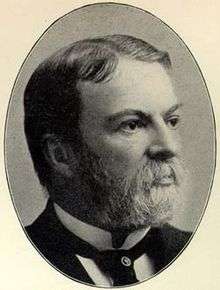
The firm's founders were Joseph Miller Wilson (1838–1902), architect and civil engineer, John Allston Wilson (1837–96), civil engineer, and Frederick Godfrey Thorn (c. 1837–1911), architect and civil engineer. Youngest brother Henry W. Wilson (1844–1910), civil engineer, joined the firm in 1886, and was promoted to partner in 1899. All three Wilson brothers attended Rensselaer Polytechnic Institute in Troy, NY. Joseph also studied metallurgy at the University of Pennsylvania.
Joseph worked in the construction department of the Pennsylvania Railroad (PRR) from 1860 to 1876, designing bridges and railroad structures, including several commuter stations on the Main Line. For a PRR subsidiary, he designed the Baltimore & Potomac Railroad Passenger Terminal in Washington, DC (1873–77, demolished 1908), the station in which U.S. President James A. Garfield was assassinated in 1881. The National Gallery of Art now occupies its site at 6th Street & Constitution Avenue on the National Mall. John did engineering work for several railroads, including the PRR and the Reading Railroad. Wilson Brothers & Company was founded on January 1, 1876.
For the 1876 Centennial Exposition, Henry Petit and Joseph M. Wilson co-designed the Main Exhibition Building—the largest building in the world, 1,876 feet (572 m) in length and enclosing 21-1/2 acres. The pair also designed Machinery Hall, and oversaw construction of the other principal buildings.[2] Joseph co-authored a 3-volume history of the Philadelphia World's Fair.[3]
Joseph's commission for Philadelphia's Presbyterian Hospital (1874), may be related to later work on Presbyterian churches, nursing homes and an orphanage. The firm's extensive work for financer Anthony J. Drexel, the city's wealthiest citizen and a Roman Catholic, may have led to subsequent commissions for convents and Catholic hospitals. In Philadelphia, the firm designed the headquarters for the Baldwin Locomotive Works (pre-1885, demolished); and, in Beach Haven, NJ, the Baldwin Hotel (1883, burned 1960), Holy Innocents Episcopal Church (1881–82), and a number of summer homes for company executives.
In 1881, the PRR hired the firm to design its main passenger terminal at Broad & Filbert Streets in Center City Philadelphia, directly west of City Hall. This was one of the first steel-framed buildings in America to use masonry not as structure, but as a curtain wall (as skyscrapers do).[4] The station was widely admired; 15% of the architects in an 1885 poll voted it one of "The Best Ten Buildings in the United States."[5] Eleven years later, the Wilson Brothers' Gothic Revival station was incorporated into Frank Furness's far larger Broad Street Station. The Wilsons designed its new train shed, at the time (1892), the largest single-span train shed in the world.
In 1885, the Wilsons designed a high-ceilinged, 2-story banking house for Drexel & Company, on the southeast corner of 5th & Chestnut Streets in Philadelphia. Four years later, Drexel wished to expand, but Independence National Bank next door refused to sell. In response, Joseph Wilson designed the Drexel Building, a 10-story, H-shaped addition that surrounded Independence National Bank on the east, west and south sides, permanently depriving the neighbor of sunlight. The iron-skeletoned addition was built atop Drexel's banking house, and was one of the first examples of X-bracing. One of the buildings demolished for this was Library Hall, the Library Company of Philadelphia's headquarters, that had been design by William Thornton (1789–91). In an ironic turn of events, the Drexel Building itself was demolished in 1959, and a replica of Library Hall was built on its original site by the American Philosophical Society.
Following the deaths of the two older brothers, the firm continued as Wilson, Harris and Richards.
Selected Architectural Works
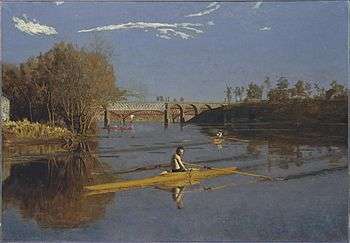


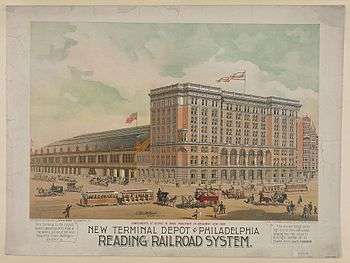
1876 Centennial Exposition
- Memorial Hall (Herman Schwarzmann, architect; Joseph M. Wilson, engineer) (1875–76)[6]
- Main Exhibition Building (Henry Petit, architect; Joseph M. Wilson, engineer) (1875–76, disassembled and sold 1881)[7]
- Machinery Hall (Henry Petit, architect; Joseph M. Wilson, engineer) (1875–76, disassembled and sold 1881)[8]
Pennsylvania Railroad
- Pennsylvania Railroad, Connecting Railway Bridge over Schuylkill River, Philadelphia, PA (attributed to John A. Wilson, engineer) (1866–67)[9] (altered 1915)[10]
- Bryn Mawr Station, Bryn Mawr, PA (1869, demolished 1963)[11]
- Wynnewood Station, Wynnewood, PA (1870)[12]
- Haverford Station, Haverford, PA (c. 1870)[13] (some sources claim it was built in 1880)[14]
- Bryn Mawr Hotel, Bryn Mawr, PA (1871, burned 1889, replaced by 1890 Frank Furness hotel)[15]
- Ardmore Station, Ardmore, PA (pre-1874, demolished)[16]
- Broad Street Station, Philadelphia, PA (1881, expanded by Frank Furness 1892–93, demolished 1953)[17]
- Wayne Railroad Station, Jct. of N. Wayne Ave. and Station Rd. Wayne, Pennsylvania (1884), NRHP-listed.
- Pennsylvania Railroad Bridge over Delaware River, Trenton, NJ (pre-1885, demolished)[18]
- Pennsylvania Railroad Bridge over Susquehanna River, west of Harrisburg, PA (pre-1885, demolished)[19]
- Train shed for expanded Broad Street Station, Philadelphia, PA (1892, burned 1923).
Philadelphia Buildings
- Reading Railroad Overpass (John A. Wilson, engineer) (1871) [20]
- Spring Garden Pumping Station, East River Drive, Fairmount Park (Joseph M. Wilson, architect) (pre-1874, demolished)[21]
- Presbyterian Hospital (Joseph M. Wilson, architect) (1874, demolished)[22]
- Joseph D. Potts house alterations (Joseph M. Wilson, architect) (1876), formally WXPN-FM, and now the University of Pennsylvania Press[23]
- A.J. Holman and Company, 1222-26 Arch St. (1881), NRHP-listed.
- St. Andrew Episcopal Church, now St. Andrew & St. Monica Episcopal Church, Powelton Village (1883–85, rebuilt after 1897 fire)[24]
- Presbyterian Home for Aged Couples and Men (pre-1885, demolished 2006)[25]
- Drexel & Company Banking House, SE corner 5th & Chestnut Sts. (1885, expanded 1889, demolished 1959).
- Drexel Institute of Technology, now Main Building, Drexel University (1888–91)[26]
- Home for Indigent Women, now Ralston House (1889)[27]
- Pennsylvania School for the Deaf, 7500 Germantown Ave. (1890), NRHP-listed.
- George W. Childs Drexel mansion (1891), now Alpha Tau Omega Fraternity, University of Pennsylvania[28]
- Reading Terminal Trainshed (1891–93), NRHP-listed.[29]
- Physicians & Dentists Office Building, 1830–32 Chestnut Street (1896), NRHP-listed.
- Philadelphia Commercial Museum (1897–99, demolished)[30]
- United Gas Improvement Company Office Building (1898)[31]
- Land Title Building, 608–10 Chestnut Street (1899)[32]
- Wayne Junction Station (Reading Railroad), 4481 Wayne Avenue (1899-1900), NRHP-listed.
Buildings Elsewhere
- Baltimore & Potomac Railroad Passenger Terminal (6th Street Station), Washington, DC (1873–77, demolished 1908)[33]
- State Hospital for the Insane, Norristown, PA (1878–80)[34]
- Holy Innocents Episcopal Church, Beach Haven, NJ (1881–82),[35] now Long Beach Island Museum.[36] Part of Beach Haven Historic District.
- "Chetwynd" (John H. Converse house), Lancaster Pike, Rosemont, PA (1882–83, expanded 1887 & 1890, demolished). Converse was a partner in Baldwin Locomotive Works.
- Baldwin Hotel, Beach Haven, NJ (1883, burned 1960)[37]
- Norman Williams Public Library, Woodstock, VT (1883–84)[38][39]
- Milton Railroad Station, 41 Dock Rd. Milton, NY (1883), NRHP-listed.
- Leander McCormick Observatory, 600 McCormick Rd. Charlottesville, VA (1884, with Warner & Swasey;Spooner), NRHP-listed.
- Astronomical Observatory, U.S. Military Academy, West Point, NY (pre-1885)[40]
- Dr. Edward H. Williams House, 506 S. Atlantic Ave. Beach Haven, NJ (1886), NRHP-listed. Now Williams Cottage Inn.[41]
- Central Railroad of New Jersey Station, Jim Thorpe, PA (1888), NRHP-listed.
- Morton station renovation in 1880 (orig.1867). The design is believed to have been inspired by Frank Furness' Glen Mills Station, on the West Chester Railroad.
- Quakertown Passenger and Freight Station, Front and East Broad Sts. Quakertown, PA (1889), NRHP-listed.
- Converse Cottage, 504 Atlantic Ave. Beach Haven, NJ (1890), NRHP-listed.
- Central Railroad of New Jersey Freight Station, 602 W. Lackawanna Ave Scranton, PA (1891), NRHP-listed.
- Tuckahoe Station, Railroad Ave. Tuckahoe, NJ (1894), NRHP-listed.
- Williams Science Hall, University of Vermont, Burlington, VT, (1894–96).[42]
- Reading Railroad Station, Lebanon, Pennsylvania (1900), NRHP-listed.
- St. Hubert's Inn, St. Huberts, NY (1890), now Ausable Club, Adirondack Mountain Reserve. NRHP-listed
- Union Station Train Shed, Richmond, VA (1900)[43] at Historic American Buildings Survey
- Main Street Station, Richmond, Virginia (1901) (as Wilson, Harris and Richards)[44]
- Stewart Hall, West Virginia University campus Morgantown, WV (1900–02), NRHP-listed.
- Riverbank Laboratories, 1512 Batavia Ave. Geneva, IL (1912), NRHP-listed.
- Geneva, Illinois: Buildings in the Central Geneva Historic District and the North Geneva Historic District.
- Elliott Building, 1401 Woodward Ave. Detroit, Mi(1894): Building in the Lower Woodward Avenue Historic District.
.jpg) Pennsylvania Railroad, Connecting Railway Bridge over Schuylkill River (1866–67), John A. Wilson, engineer. This 2-track bridge was widened to 5 tracks in 1915.
Pennsylvania Railroad, Connecting Railway Bridge over Schuylkill River (1866–67), John A. Wilson, engineer. This 2-track bridge was widened to 5 tracks in 1915. Bryn Mawr Station, Pennsylvania Railroad, Bryn Mawr, PA (1869, demolished 1963).
Bryn Mawr Station, Pennsylvania Railroad, Bryn Mawr, PA (1869, demolished 1963). Wynnewood Station, Pennsylvania Railroad, Wynnewood, PA (1870).
Wynnewood Station, Pennsylvania Railroad, Wynnewood, PA (1870). Haverford Station, Pennsylvania Railroad, Haverford, PA (c. 1870).
Haverford Station, Pennsylvania Railroad, Haverford, PA (c. 1870). Spring Garden Pumping Station, East River Drive, Philadelphia, PA (pre-1874, demolished pre-1915). John A. Wilson's Pennsylvania Railroad Connecting Bridge (1866–67) can be seen in the background.
Spring Garden Pumping Station, East River Drive, Philadelphia, PA (pre-1874, demolished pre-1915). John A. Wilson's Pennsylvania Railroad Connecting Bridge (1866–67) can be seen in the background. Interior of Machinery Hall, Centennial Exposition (1875–76, demolished 1881).
Interior of Machinery Hall, Centennial Exposition (1875–76, demolished 1881). Interior of Joseph D. Potts house, 3905 Spruce St., Philadelphia, PA (1850, altered by Joseph M. Wilson 1876), now WXPN-FM, University of Pennsylvania.
Interior of Joseph D. Potts house, 3905 Spruce St., Philadelphia, PA (1850, altered by Joseph M. Wilson 1876), now WXPN-FM, University of Pennsylvania.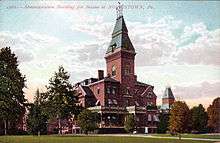 State Hospital for the Insane, Norristown, PA (1878–80).
State Hospital for the Insane, Norristown, PA (1878–80). Holy Innocents Episcopal Church, Beach Haven, NJ (1881–82), now Long Beach Island Historical Society and Museum.
Holy Innocents Episcopal Church, Beach Haven, NJ (1881–82), now Long Beach Island Historical Society and Museum. "Chetwynd" (John H. Converse house), Rosemont, PA (1882–83, expanded 1887 & 1890, demolished 1960s).
"Chetwynd" (John H. Converse house), Rosemont, PA (1882–83, expanded 1887 & 1890, demolished 1960s). Norman Williams Public Library, Woodstock, Vermont (1883–84).
Norman Williams Public Library, Woodstock, Vermont (1883–84). Drexel & Company Banking House, SE corner 5th & Chestnut Sts., Philadelphia, PA (1885, expanded 1889, demolished 1959).
Drexel & Company Banking House, SE corner 5th & Chestnut Sts., Philadelphia, PA (1885, expanded 1889, demolished 1959). Main Building, Drexel University, Philadelphia, PA (1888–91).
Main Building, Drexel University, Philadelphia, PA (1888–91).- Interior, Main Building, Drexel University.
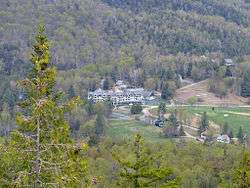 St. Hubert's Inn, St. Huberts, NY (1890), (now Ausable Club, Adirondack Mountain Reserve).
St. Hubert's Inn, St. Huberts, NY (1890), (now Ausable Club, Adirondack Mountain Reserve).- George W. Childs Drexel mansion (now Alpha Tau Omega Fraternity), University of Pennsylvania, Philadelphia, PA (1891).
 Broad Street Station trainshed, Philadelphia, PA (1892–94, burned 1923). This had the largest single span, 306 ft. (91 m.), of any trainshed in the world.
Broad Street Station trainshed, Philadelphia, PA (1892–94, burned 1923). This had the largest single span, 306 ft. (91 m.), of any trainshed in the world.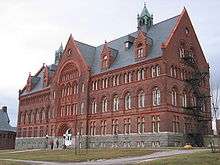 Williams Science Hall, University of Vermont, Burlington, VT (1894–96).
Williams Science Hall, University of Vermont, Burlington, VT (1894–96).- Physicians & Dentists Office Building, Philadelphia, PA (1896).
- Reading Railroad Station, Lebanon, Pennsylvania (1900)
References
- ↑ Wilson Bros. & Co.'s 1885 Catalogue lists 432 railroad bridges, 42 highway bridges, 141 railroad stations, and almost 200 industrial buildings. Wilson Brothers & Company, Catalogue, pp. 9–29.
- ↑ George E. Thomas, "Design for the Main Exhibition Building, Philadelphia Centennial Exposition," in James F. O'Gorman, et al., Drawing Toward Building: Philadelphia Architectural Graphics, 1732–1986 (Philadelphia: University of Pennsylvania Press, 1986), pp. 140–42.
- ↑ Earl Shinn, Walter Smith & Joseph M. Wilson, Masterpieces of the Centennial International Exhibition Illustrated (Philadelphia: Gebbie & Barrie, 1876–78).
- ↑ Thomas, Drawing Toward Building, pp. 140–42.
- ↑ American Architect and Building News, June 13, 1885, pp. 283–85. Philadelphia City Hall was the only other Philadelphia building listed in the top 20.
- ↑ Memorial Hall at Historic American Buildings Survey
- ↑ Main Exhibition Building from Philadelphia Architects and Buildings
- ↑ Machinery Hall from Philadelphia Architects and Buildings
- ↑ PRR Connecting Railway Bridge from Bryn Mawr College
- ↑ PRR Connecting Railway Bridge at Historic American Buildings Survey
- ↑ Bryn Mawr Station at Historic American Buildings Survey
- ↑ Wynnewood Station at Historic American Buildings Survey
- ↑ Haverford Station at Lower Merion Historical Society
- ↑ Existing Stations in Montgomery County, Pennsylvania
- ↑ 1st Bryn Mawr Hotel from Philadelphia Architects and Buildings
- ↑ Ardmore Train Station from Philadelphia Architects and Buildings
- ↑ Broad Street Station at Historic American Buildings Survey
- ↑ Delaware River Bridge from Philadelphia Architects and Buildings
- ↑ Susquehanna River Bridge from Philadelphia Architects and Buildings
- ↑ Reading Railroad Overpass at Historic American Buildings Survey
- ↑ Spring Garden Pumping Station at Historic American Building Survey.
- ↑ Presbyterian Hospital from Bryn Mawr College
- ↑ Potts House at Historic American Buildings Survey
- ↑ St. Andrew's from Philadelphia Architects and Buildings
- ↑ Presbyterian Home from Philadelphia Architects and Buildings
- ↑ Drexel Institute at Historic American Buildings Survey
- ↑ Ralston House from Philadelphia Architects and Buildings
- ↑ Drexel Mansion from Philadelphia Architects and Buildings
- ↑ Reading Terminal Trainshed at Historic American Buildings Survey
- ↑ Commercial Museum from Philadelphia Architects and Buildings
- ↑ United Gas Improvement from Philadelphia Architects and Buildings
- ↑ Land Title Building from Philadelphia Architects and Buildings
- ↑ B&P Station from National Gallery of Art
- ↑ Norristown State Hospital from Flickr
- ↑ LBI Museum at Historic American Buildings Survey
- ↑ lbimuseum.org
- ↑ Baldwin Hotel from Philadelphia Architects and Buildings
- ↑ normanwilliams.org
- ↑ Norman Williams Library from Philadelphia Architects and Buildings
- ↑ West Point Observatory from Philadelphia Architects and Buildings
- ↑ williamscottageinn.com
- ↑ Williams Science Hall
- ↑ Union Station Train Shed
- ↑ Potter, Janet Greenstein (1996). Great American Railroad Stations. New York: John Wiley & Sons, Inc. p. 287. ISBN 978-0471143895.
- ↑ "A BOOM IN BUILDING". Detroit Free Press. Detroit Free Press. Detroit Free Press. March 4, 1894.
| Wikimedia Commons has media related to Wilson Brothers & Company. |
- Wilson Brothers & Company, A Catalogue of Work Executed (Philadelphia: Lippincott, 1885).
- Project List – Wilson Brothers & Company – at Philadelphia Architects and Buildings
